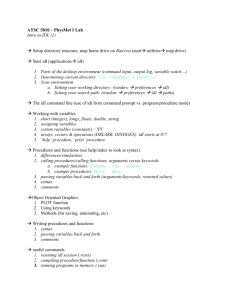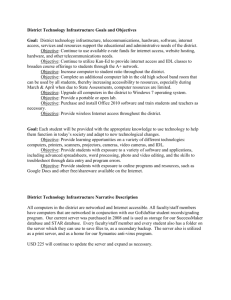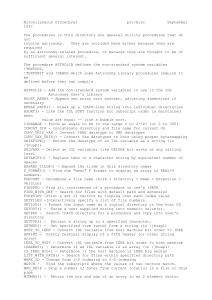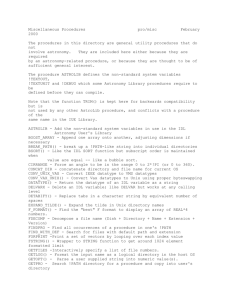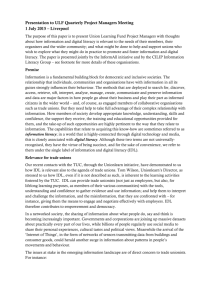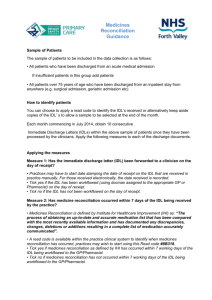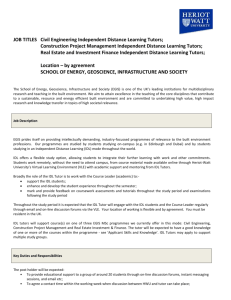Making Regular Expressions Your Friends
advertisement
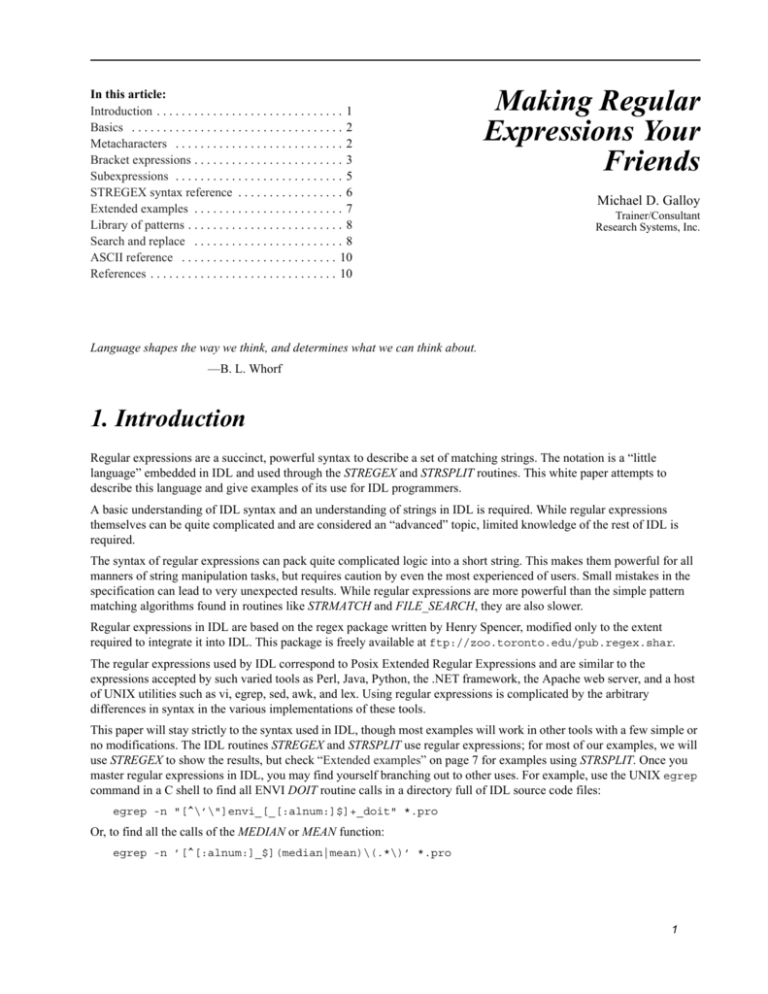
In this article:
Introduction . . . . . . . . . . . . . . . . . . . . . . . . . . . . . . 1
Basics . . . . . . . . . . . . . . . . . . . . . . . . . . . . . . . . . . 2
Metacharacters . . . . . . . . . . . . . . . . . . . . . . . . . . . 2
Bracket expressions . . . . . . . . . . . . . . . . . . . . . . . . 3
Subexpressions . . . . . . . . . . . . . . . . . . . . . . . . . . . 5
STREGEX syntax reference . . . . . . . . . . . . . . . . . 6
Extended examples . . . . . . . . . . . . . . . . . . . . . . . . 7
Library of patterns . . . . . . . . . . . . . . . . . . . . . . . . . 8
Search and replace . . . . . . . . . . . . . . . . . . . . . . . . 8
ASCII reference . . . . . . . . . . . . . . . . . . . . . . . . . 10
References . . . . . . . . . . . . . . . . . . . . . . . . . . . . . . 10
Making Regular
Expressions Your
Friends
Michael D. Galloy
Trainer/Consultant
Research Systems, Inc.
Language shapes the way we think, and determines what we can think about.
—B. L. Whorf
1. Introduction
Regular expressions are a succinct, powerful syntax to describe a set of matching strings. The notation is a “little
language” embedded in IDL and used through the STREGEX and STRSPLIT routines. This white paper attempts to
describe this language and give examples of its use for IDL programmers.
A basic understanding of IDL syntax and an understanding of strings in IDL is required. While regular expressions
themselves can be quite complicated and are considered an “advanced” topic, limited knowledge of the rest of IDL is
required.
The syntax of regular expressions can pack quite complicated logic into a short string. This makes them powerful for all
manners of string manipulation tasks, but requires caution by even the most experienced of users. Small mistakes in the
specification can lead to very unexpected results. While regular expressions are more powerful than the simple pattern
matching algorithms found in routines like STRMATCH and FILE_SEARCH, they are also slower.
Regular expressions in IDL are based on the regex package written by Henry Spencer, modified only to the extent
required to integrate it into IDL. This package is freely available at ftp://zoo.toronto.edu/pub.regex.shar.
The regular expressions used by IDL correspond to Posix Extended Regular Expressions and are similar to the
expressions accepted by such varied tools as Perl, Java, Python, the .NET framework, the Apache web server, and a host
of UNIX utilities such as vi, egrep, sed, awk, and lex. Using regular expressions is complicated by the arbitrary
differences in syntax in the various implementations of these tools.
This paper will stay strictly to the syntax used in IDL, though most examples will work in other tools with a few simple or
no modifications. The IDL routines STREGEX and STRSPLIT use regular expressions; for most of our examples, we will
use STREGEX to show the results, but check “Extended examples” on page 7 for examples using STRSPLIT. Once you
master regular expressions in IDL, you may find yourself branching out to other uses. For example, use the UNIX egrep
command in a C shell to find all ENVI DOIT routine calls in a directory full of IDL source code files:
egrep -n "[^\’\"]envi_[_[:alnum:]$]+_doit" *.pro
Or, to find all the calls of the MEDIAN or MEAN function:
egrep -n ’[^[:alnum:]_$](median|mean)\(.*\)’ *.pro
1
2
Making Regular Expressions Your Friends
2. Basics
To perform a search using a regular expression, a string to be searched and a string specifying the search pattern are
needed. In the simplest case, the search pattern is a sequence of literal characters which STREGEX will attempt to locate.
For example, to find the sequence of letters “ik” in the string “Mike,” use:
IDL> print, stregex('Mike', 'ik')
1
STREGEX returns the position of the search pattern within the first string or -1 if it doesn’t find it. Setting the boolean
keyword EXTRACT would make STREGEX return the matching string itself instead of its position.
If there is more than one match in the given string, the regular expression will match the one that starts first in the string.
If there are multiple substrings that match starting at the same position, the regular expression will return the longest
match (“greedy” matching).
So far, we haven’t done anything that can’t be done with STRPOS. In fact, STRMATCH can do better. The next section,
“Metacharacters”, will describe what gives regular expressions their power.
3. Metacharacters
Most characters, like numbers and letters, match themselves in a regular expression. These are called ordinary characters.
A metacharacter is any of the characters that regular expressions do not interpret literally. The metacharacters are \ [ ]
( ) ? * + { } ^ $ . |. Metacharacters can be used as wildcards, to match certain groups of characters, to indicate a
repeating pattern, and to match things not corresponding to a character such as the beginning or ending of a line.
. DOT
The period matches any character.
IDL> print, stregex(['eMike', 'iMike'], '.Mike', /extract)
eMike iMike
? * + { } REPETITION CHARACTERS
These are the various repetition characters. They can be used to indicate how many times the character or expression
immediately to the left of the operators should be matched. Use parenthesis to indicate the expression that should be
repeated if it is more than a single character.
Metacharacters
Matches
?
Optional, matches 0 or 1 times
ab?a matches aa or aba
*
Matches 0 or more times
ab*a matches aa, aba, abba, abbba, etc.
+
Matches 1 or more times
a+ matches a, aa, aaa, etc.
{n}
Matches exactly n times
ab{2}a matches abba only
Matches from m to n times
ab{2,4}b matches abba, abbba, abbbba
{m,n}
Example
Table 9-1: Repetition metacharacters.
IDL> print, stregex(['abbcccde', 'bbccccd'], 'a?b{2}c{3,5}d+e*')
0
0
4. Bracket expressions
3
^ $ ANCHOR CHARACTERS
These are the anchor characters. They match the beginning (^) and the end ($) of a string. These are zero-width
“characters” and nothing is included in the result representing them.
IDL> print, stregex(['and two', 'one and two', 'one and', 'and'], '^and')
0
-1
-1
0
IDL> print, stregex(['and two', 'one and two', 'one and', 'and'], 'and$')
-1
-1
4
0
IDL> print, stregex(['and two', 'one and two', 'one and', 'and'], '$and$')
-1
-1
-1
-1
The ^ will only produce a match if it is the first (or $ the last) character in the search pattern.
| ALTERNATION
The | symbol represents alternation. It specifies choices which are allowable at that point in the regular expression. Use
parenthesis to indicate an alternation in a larger regular expression.
IDL> print, stregex('Jodie', 'George|Jane|Elroy|Jodie', /extract)
Jodie
IDL> print, stregex('Elroy Jetson', '(George|Jane|Elroy|Jodie) Jetson', /extract)
Elroy Jetson
[ ] BRACKET EXPRESSIONS
The [] characters are used to produce a bracket expression. These are used to allow a choice of different characters at
that point in the regular expression. See “Bracket expressions” on page 3 for more information.
( ) SUBEXPRESSIONS
The () characters are used to indicate a subexpression. These are used in alternation (see the | metacharacter below) or
in extracting subexpressions from a larger matching expression. See “Subexpressions” on page 5 for more information.
\ ESCAPE CHARACTER
The backslash is used to escape the meaning of a metacharacter (including itself). So to match the * character use \* as
in:
IDL> print, stregex('1*2=2', '1\*2', /extract)
1*2
IDL> file = 'C:\RSI\IDL56\examples\data\glowing_gas.jpg'
IDL> print, stregex(file, 'C:\\', /extract)
C:\
4. Bracket expressions
Bracket expressions provide a set of characters to match. These can be created from a list of characters, a range of
characters, or a set of excluded characters.
The simplest case is a list of valid characters. For example, the following is an example of matching a sequence of one or
more vowels:
IDL> print, stregex('Fountain', '[aeiou]+', /extract)
ou
The normal metacharacters lose their special meaning in a bracket expression, while he characters ^, -, and some
combinations with [ and ] gain a special meaning.
4
Making Regular Expressions Your Friends
4.1. Range expressions
Instead of listing each character in the character class, a range can be specified by a starting character and an ending
character. The ordering is determined by the ascii lookup table (see Table 9-3 for details). So, to get the lowercase letters
from a to m, the range [a-m] could be used. Of course, [%-+] is also legal, but not recommended. Multiple ranges can be
combined to form expressions such as [A-Za-z], which matches any letter. It is illegal to specify a range backwards
(with the first endpoint of the range having a higher ASCII value than the second endpoint).
The one tricky thing to do with ranges is to specify a range which includes a character that is special in bracket
expressions (ie. -, [, ], or ^). To do this, use a collating element to specify the character of the range. Collating elements
are specified by placing the given character within [. and .]. For example, to specify the range of characters from - to 0
(which is -, ., /, and 0), use [[.-.]-0]. Normally, it would be simpler to just use an expression such as [-./0] to
indicate this range.
4.2. Character classes
A character class is a named listing of characters which can be used in a bracket expression. There are character classes
for common sets of characters such as letters, digits, whitespace, etc. There are twelve character classes available in IDL;
they are listed in Table 9-2.
To use character classes in a bracket expression, include the name of the class inside [: and :]. The character class names
are case-sensitive and must be specified in lowercase. For example, to match a sequence of one or more alphabetic
characters, try:
IDL> print, stregex(’Test expression’, ’[[:alpha:]]+’, /extract)
Test
Note that there are nested bracket expressions, one to open the bracket expression and one to indicate the character class.
More complicated bracket expressions could allow for multiple character classes, as in:
IDL> print, stregex('1+2=3 is true', '[[:digit:][:punct:]]+', /extract)
1+2=3
It would also be possible to mix ranges, characters, and character classes in a bracket expression, like:
IDL> print, stregex('aBE5C', '[A-BE[:digit:]]+', /extract)
BE5
Class
Description
alnum
alphanumeric characters, equivalent to 0-9A-Za-z
alpha
alphabetic characters, regardless of case, equivalent to A-Za-z; avoid A-z
as it matches the characters [\]^_‘ as well.
blank
tab and space characters
cntrl
control characters, ASCII characters 1-31 and 127
digit
decimal digits, equivalent to 0-9
graph
graphable characters, in other words, the characters that will show up on the
screen (the printable characters except space), ASCII characters 33-126
lower
lowercase letters, equivalent to a-z
print
printable characters, ASCII characters 32-126
Table 9-2: Character classes in IDL regular expressions. See Table 9-3 on page 10 for ASCII character references.
5. Subexpressions
5
Class
Description
punct
punctuation characters; the following characters are considered punctuation:
!"#$%&’()*+,-./:;<=>?@[\]^_‘{|}~
space
whitespace characters, ASCII characters 9-13, 32
upper
uppercase letters, equivalent to A-Z
xdigit
hexadecimal digits, equivalent to 0-9A-Fa-f
Table 9-2: Character classes in IDL regular expressions. See Table 9-3 on page 10 for ASCII character references.
4.3. Non-matching lists
When the first character of a bracket expression is a ^ (caret), then the rest of the bracket expression is a non-matching list
instead of a matching list. So for example, [^ab] matches any character except a or b. Any valid bracket expression can
be negated by slipping a ^ in right after the opening [ (except for a bracket expression that is already negated—no double
negatives in regular expressions).
A character class can be negated, using the same notation. So [^[:alpha:]] matches any non-alphabetic character and
[^[:lower:][:digit:]] matches any character except lowercase letters or decimal digits.
A word of warning, if you want to specify a bracket expression which includes the literal character ^, make sure to not put
it first accidently negating the bracket expression. So to get a match on common mathematical operators use [+-*/^]
instead of [^+-*/].
4.4. Miscellaneous
It is also possible to match zero width "characters" such as the beginning or ending of a word with [.<.] and [.>.] in a
bracket expression. A word is defined to be a sequence of word characters (alnum character class and _) where there are
no word characters immediately before or after the sequence.
IDL> print, stregex('George and Mike', '[[:space:]]Mike', /extract)
Mike
IDL> print, stregex('George and Mike', '[[:<:]]Mike', /extract)
Mike
The first expression specifically requires the matching string to start with a character from the space character class,
while the second expression requires there is not word character before the matching string. So the first expression
matches five characters (starting with a space) and the second matches only four characters. Note that first expression
would not match if the line started with “Mike” while the second expression would match.
5. Subexpressions
Subexpressions are used in two contexts:
• with alteration or repetition operators
• to locate a subexpression (using STREGEX’s SUBEXPR keyword)
In the first case, for example:
IDL> print, stregex(['ac', 'bc', 'cc'], '(a|b)c')
0
0
-1
IDL> print, stregex('ababab', '(ab)+', /extract)
ababab
6
Making Regular Expressions Your Friends
In the second case, used in conjunction with the STREGEX’s SUBEXPR keyword, subexpressions can return the location
of a subexpression within a larger matching regular expression.
For example, here both the full match and a subexpression of the match are returned:
IDL> print, stregex('Mike', 'M(.*)', /extract, /subexpr)
Mike ike
Note that even if the SUBEXPR keyword is set, when parentheses are used as a grouping mechanism for repetition, only
the first match is returned as part of the result, not a match for each repetition. Another way of calculating this is that the
number of subexpressions returned is equal to the number of pairs of parentheses in the regular expression. Also,
parenthesis may be nested; the subexpressions are returned in the order of the location of the opening parenthesis.
IDL> print, stregex('abc', '((a)b)c', /subexpr, /extract)
abc ab a
6. STREGEX syntax reference
Result = STREGEX( StringExpression, RegularExpression [, /FOLD_CASE]
[, /BOOLEAN | , /EXTRACT | , LENGTH=variable [, /SUBEXPR]] )
Result
By default IDL returns the location (or an array of locations, if StringExpression is a string array) of the match or -1 if
there was no match. If the BOOLEAN keyword is set, the return value will be 0 (if not found) or 1 (if found). If the
EXTRACT keyword is set, it will return the matching string or the empty string, if no match is found.
StringExpression
The StringExpression is a string or string array to be matched. If a string array, the regular expression tries to match on
each element of the array independently and returns its results (and through the LENGTH keyword) as an array.
RegularExpression
The RegularExpression is always a scalar string containing the regular expression to match.
BOOLEAN
Set this boolean keyword to have STREGEX return 0 (false) or 1 (true) indicating whether the regular expression was
matched.
IDL> print, stregex(['Test sentence', 'Test was here'], 'was')
-1
5
IDL> print, stregex(['Test sentence', 'Test was here'], 'was', /boolean)
0
1
EXTRACT
The EXTRACT keyword changes the return value to the matched strings instead of their locations. The EXTRACT
keyword cannot be used with the BOOLEAN or LENGTH keywords.
FOLD_CASE
Set this boolean keyword to have STREGEX perform case-insensitive matching. The default is case-sensitive matching.
IDL> print, stregex('Mike', '[a-z]+', /extract)
ike
IDL> print, stregex('Mike', '[a-z]+', /extract, /fold_case)
Mike
7. Extended examples
7
LENGTH
Set to a named variable to return the length in characters of the returned strings. Together with the result of this
function, which contains the starting points of the matches in StringExpression, LENGTH can be used with the STRMID
function to extract the matched substrings.
IDL> str = 'Mike'
IDL> pos = stregex('Mike', 'ik', length=len)
IDL> print, pos, len
1
2
IDL> print, strmid(str, pos, len)
ik
This keyword can not be used in conjunction with the BOOLEAN or EXTRACT keywords.
SUBEXPR
See “Subexpressions” on page 5 for more information about using the SUBEXPR keyword to return the location of a
subexpression. The size of the return value and the LENGTH keyword is determined from both the dimensions of the
StringExpression parameter and the number of parenthesis in the RegularExpression parameter. The dimensionality of
this result has a first dimension equal to the number of parenthesis in the regular expression plus one and the remaining
dimensions are copied from the dimensions of the StringExpression parameter. So for example, for a string expression
which was 2 by 3 and a regular expression with 3 sets of parenthesis:
IDL> str_expr = [['a', 'eabcd'], ['b', 'c'], ['abcde', 'abcde']]
IDL> result = stregex(str_expr, '(a)(bc)(d)', /subexpr)
IDL> help, result
RESULT
LONG
= Array[4, 2, 3]
Note that parenthesis used with quantity operators only return a single subexpression match (not one for each time they
match). So (a)+ would match only the first a in the subexpression result (but all the a’s in the full result).
7. Extended examples
To search for PNG or JPG files in the IDL distribution on the C: drive onWindows:
IDL>
IDL>
IDL>
IDL>
files = file_search(filepath(''), '*')
valid_name = '[[:alpha:]_.][[:alnum:]_.]*'
re = 'C:\\(' + valid_name + '\\)*' + valid_name + '\.(png|jpg)'
print, stregex(files, re, /extract, /fold_case)
The STRSPLIT routine excepts a regular expression for its second positional parameter when the REGEX keyword is set.
It is often useful to split a string on any number of white space characters. This is simple with STRSPLIT and regular
expressions:
IDL> result = strsplit('Mike was here', '[[:space:]]', /extract, /regex)
IDL> help, result[0], result[1], result[2]
<Expression>
STRING
= 'Mike'
<Expression>
STRING
= 'was'
<Expression>
STRING
= 'here'
The end of word bracket expression can be used to split a string without loss of any of the characters of the original string.
IDL> result = strsplit('Mike was here', '[[:>:]]', /extract, /regex)
IDL> help, result[0], result[1], result[2]
<Expression>
STRING
= 'Mike'
<Expression>
STRING
= ' was'
<Expression>
STRING
= ' here'
8
Making Regular Expressions Your Friends
8. Library of patterns
Most of these patterns have some drawbacks and are not robust enough to catch all the special cases involved in matching
patterns of the specified type. Rather, they are intended to be examples of the type of uses to which regular expressions are
put.
<[^>]+>
XML tag
(...) (...) (..) (..):(..):(..) (....)
You can easily pull out the pieces of the result of the SYSTIME function using the above regular expression. Note that
this does not validate whether a string is a SYSTIME result very well.
(.[[:digit:]]+|[[:digit:]]+.?[[:digit:]]*)([Ee][+-]?[[:digit:]]+)?
floating point value, possibly in scientific notation, examples.
;.*$
comment on a line of IDL code (includes a ; in a literal string)
^[^@ ]+@([^. ]+\.)+(com|edu|gov)$
Valid email, more valid top-level domain names, some restrictions characters allowed in domain names and
usernames, IP addresses, etc. It would be easy to use STREGEX with the BOOLEAN keyword set to create an email
validation.
[[:alpha:]_][[:alnum:]_$]*
IDL variable name
9. Search and replace
It is common to not only search for a particular pattern, but to replace the pattern with another. STR_REPLACE addresses
that need. It is available at: http://internal/~mgalloy/idl/mine/misc/str_replace.html.
Result = STR_REPLACE( StringExpression, SearchPattern, Replacement, [, /FOLD_CASE]
[, /GLOBAL ] [, /EVALUATE] )
StringExpression
A scalar string to be searched
SearchPattern
A regular expression which specifies which substrings are to be replced. Can reference subexpressions in the
replacement.
Replacement
The string to replace the search pattern with. Use $1, $2, etc. to refer to subexpressions in the SearchPattern, while $&
refers to the entire match.
FOLD_CASE
Indicating the searching will be case-insentive, but the replacement will not change any case.
GLOBAL
The default is to find the first match and stop; set the GLOBAL keyword to find and replace all occurances of the search
pattern.
9. Search and replace
9
EVALUATE
Set the EVALUATE keyword to indicate that the Replacment expression is IDL code and not literal expression.
9.1. Examples
The following shows the simplest use of STR_REPLACE, to replace one literal string with another.
IDL> print, str_replace('Mike was here', 'was', 'was not')
Mike was not here
The subexpressions in the search pattern are used here in conjuction with the $1 and $2 variables in the replacement
pattern to switch the order of the first two "words" in the phrase.
IDL> print, str_replace('Mike was here', '([^ ]*) ([^ ]*)', '$2 $1')
was Mike here
The following can place commas in a string representing an integer. This could be done without the loop if commas where
placed every three digits starting from the front. But since the counting starts at the back, we have to put one comma in at
a time.
IDL> str = '1874382735872856'
IDL> regex = '^[+-]?([[:digit:]]+)([[:digit:]]{3})'
IDL> for i = 0, strlen(str)/3 - 1 do str = str_replace(str, regex, '$1,$2')
IDL> print, str
1,874,382,735,872,856
The EVALUATE keyword allows a replacement pattern which is IDL code. The match ($&) and subexpression match
variables ($1, $2, etc.) are still available.
IDL> print, str_replace('Mike5', 'Mike([0-9]+)', 'strtrim(fix($1) * 2, 2)', /evaluate)
10
In a more complicated example, we would like to convert to all caps each “word” (a capital letter followed by lowercase
letters) following the string Mike.
IDL> str = 'MikeGeorgeHenryMikeBill'
IDL> regex = 'Mike([A-Z][a-z]*)'
IDL> print, str_replace(str, regex, '"Mike"+strupcase("$1")', /evaluate, /global)
MikeGEORGEHenryMikeBILL
10
Making Regular Expressions Your Friends
10. ASCII reference
0
1
2
3
4
5
6
7
8
9
10
11
12
13
14
15
16
17
18
19
20
21
22
23
24
25
26
27
28
29
30
31
32
33
34
35
36
37
38
39
40
41
42
NUL
SOH
STX
ETX
EOT
ENQ
ACK
BEL
BS
TAB
LF
VT
FF
CR
SO
SI
DLE
DC1
DC2
DC3
DC4
NAK
SYN
ETB
CAN
EM
SUB
ESC
FS
GS
RS
US
null
start of heading
start of text
end of text
end of transmission
enquiry
acknowledge
bell
backspace
horizontal tab
NL line feed, new line
vertical feed
NP form feed, new page
carriage return
shift out
shift in
data link escape
device control 1
device control 2
device control 3
device control 4
negative acknowledge
synchronous idle
end of trans block
cancel
end of media
substitute
escape
file separator
group separator
record separator
unit separator
space
!
"
#
$
%
&
’
(
)
*
43
44
45
46
47
48
49
50
51
52
53
54
55
56
57
58
59
60
61
62
63
64
65
66
67
68
69
70
71
72
73
74
75
76
77
78
79
80
81
82
83
84
85
+
,
.
/
0
1
2
3
4
5
6
7
8
9
:
;
<
=
>
?
@
A
B
C
D
E
F
G
H
I
J
K
L
M
N
O
P
Q
R
S
T
U
86
87
88
89
90
91
92
93
94
95
96
97
98
99
100
101
102
103
104
105
106
107
108
109
110
111
112
113
114
115
116
117
118
119
120
121
122
123
124
125
126
127
V
W
X
Y
Z
[
\
]
^
_
‘
a
b
c
d
e
f
g
h
i
j
k
l
m
n
o
p
q
r
s
t
u
v
w
x
y
z
{
|
}
~
DEL
Table 9-3: ASCII reference chart. Note the punctuation marks between the uppercase and lowercase letters. This is the
standard ASCII values. Extended ASCII values are from 128 to 255.
11. References
Building IDL Applications, Chapter 9: String, Learning about regular expressions.
Basic regular expressions usage in IDL.
Friedl, Jeffrey E.F. Mastering Regular Expressions. O’Reilly & Associates, Inc., 2002.
Definitive reference for regular expressions in general.
Online help pages for STREGEX, STRSPLIT and “Learning about regular expressions.”
Details of the IDL syntax for regular expressions and syntax for STREGEX and STRSPLIT.
11. References
Robbins, Arnold. UNIX in a Nutshell.
Basic egrep usage and list of UNIX tools which use regular expressions.
Oram, Andy. “Marshall McLuhan vs. Marshalling Regular Expressions.”
http://www.oreillynet.com/pub/a/network/2002/07/08/platform.html. July 8, 2002.
Interesting article about the power of plain text and regular expressions’ role in using text.
Michael Galloy is a trainer and consultant specializing in IDL programming for Research Systems.
Recently, he has worked on the Topics in Advanced IDL manual, the What’s New in IDL 5.6 webinar, the
Performance: Code Tuning webinar, and the IDLdoc project. He enjoys playing Ulimate frisbee and
Nethack.
11
12
Making Regular Expressions Your Friends
